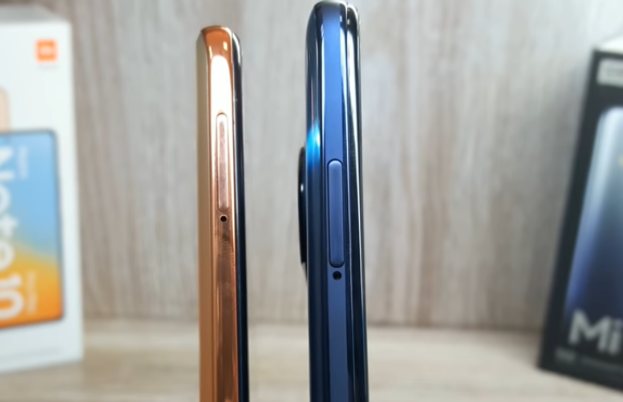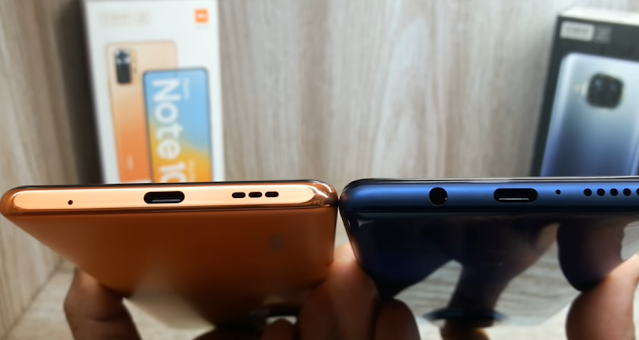Which is better? Redmi Note 10 Pro Max or the Xiaomi Mi 10i
Xiaomi has two of its smartphone lineup which includes the Mi series and another the most popular Redmi series. The Mi series is aimed at the premium flagship segment while the Redmi series is for the budget and the mid-range segment smartphones. In January, Xiaomi launched the Mi 10i which is a great 5G smartphone, and lately, now Xiaomi has come up with the Redmi Note 10 series.
The Redmi Note 10 Pro Max (Review) is the best smartphone of the Redmi Note 10 series and has almost all the features of the Xiaomi Mi 10i (Review) but there are some differences between them. Both these smartphones differ in design, chipsets, cameras, and other than that everything remains the same on both.
So which is the best Xiaomi smartphone of the two? Let’s find out in the full comparison.
Xiaomi Mi 10i vs Redmi Note 10 Pro Max Design:
Both the Xiaomi Mi 10i and the Redmi Note 10 Pro Max have a glass sandwich design with Corning Gorilla Glass 5 for protection. The design is different on both as the camera module on the Xiaomi Mi 10i has a circular setup with an LED flash whereas the Redmi Note 10 Pro Max has a rectangular camera module with the main camera on top and other three below it and to the side lies the LED flash.
The Redmi Note 10 Pro Max is slightly curved at the back whereas the Xiaomi Mi 10i is flatter. When both the smartphones are kept on the table, the camera hump of the Redmi Note 10 Pro Max is felt much compared to the Xiaomi Mi 10i. The material used on the back differs on both smartphones where the Xiaomi Mi 10i has a glossy back, the Redmi Note 10 Pro Max has a matte frosted finish.
The Xiaomi Mi 10i back catches a lot of fingerprints compared to the Redmi Note 10 Pro Max which is having a matte finish that provides better grip and also weighs at 192grams compared to 214grams on the Xiaomi Mi 10i though the Redmi Note 10 Pro Max packing a huge 5020mAh battery making it the lighter of the two.
On to the sides, both have a power button and volume buttons on the right side and a SIM card slot on the left. The Redmi Note 10 Pro Max has a triple card slot where you can use two SIM cards with a microSD card whereas, on the Xiaomi Mi 10i, it is a hybrid slot. At the bottom, both have a USB Type-C port, a loudspeaker grille, primary microphone, and the Xiaomi Mi 10i has a 3.5mm headphone jack.
The Redmi Note 10 Pro Max has a 3.5mm headphone jack at the top and both have an IR Blaster and a secondary noise-canceling microphone. The second speaker is located on the top of the Redmi Note 10 Pro Max. At the back, both have an IP53 rating which makes them somewhat water-resistant. On the front, both have a single punch hole at the center on the top. The one on the Xiaomi Mi 10i is larger.
The bezels are also slightly thicker on both sides. Overall, in terms of design, the Xiaomi Mi 10i has attractive colors whereas the build quality, in-hand feel and weight distribution are better on the Redmi Note 10 Pro Max making it the better of the two.
Xiaomi Mi 10i vs Redmi Note 10 Pro Max Display:
The biggest difference between both smartphones is in terms of display. Both have a huge 6.67 inches Full HD+ (1080×2400 pixels) display but the Redmi Note 10 Pro Max has a Super AMOLED display whereas the Xiaomi Mi 10i has an IPS LCD display. Both have a 120Hz refresh rate on the displays.
There is a slight difference between the two.
The Redmi Note 10 Pro Max has a toggle to switch between 60Hz or 120Hz whereas on the Xiaomi Mi 10i if you set the display at 120Hz, the display can scale down to as low as 30Hz in some applications and 120Hz while gaming or scrolling through webpages which makes it better than the Redmi Note 10 Pro Max as it adjusts refresh rate according to the application in use.
If you compare both displays side by side, the color reproduction is much better on the Redmi Note 10 Pro Max as it has an AMOLED display and the viewing angles are much better compared to the Xiaomi Mi 10i. Coming to brightness, the display can go as bright as 1200nits on the Redmi Note 10 Pro Max compared to the Xiaomi Mi 10i’s 500nits of brightness.
Under direct sunlight or in dark, the display on the Redmi Note 10 Pro Max has better visibility and can go very low in terms of brightness also. Both have support for Widevine L1 and HDR10 contents so streaming content from OTT platforms and Youtube is breathless. Both get a side-mounted fingerprint scanner that is fast and responsive and the face unlocks works well too.
Overall, the display feels much better on the Redmi Note 10 Pro Max compared to the Xiaomi Mi 10i and is the better one for media consumption but if you want a variable refresh rate, then the Xiaomi Mi 10i is the better option.
Xiaomi Mi 10i vs Redmi Note 10 Pro Max Performance:
In terms of performance, both differ as to the Redmi Note 10 Pro Max houses a less powerful Snapdragon 732G compared to Snapdragon 750G on the Xiaomi Mi 10i. In terms of daily performance, there is not much difference between both as both can handle all tasks easily but in most of the scenarios like opening or closing of applications and gaming, the Xiaomi Mi 10i takes the lead.
The Snapdragon 750G has almost the same octa-core setup configuration as the Snapdragon 732G except for the powerful Kryo 570 cores compared to Kryo 470 cores which provides slightly better gaming performance also. All heavy games like Call Of Duty Mobile, Asphalt 9 Legends ran fine without any frame drops noticed much.
At the highest frame rate and the very high graphics, there were some stutters noticed on the Redmi Note 10 Pro Max more compared to the Xiaomi Mi 10i but after a long time of gaming, the back of the Xiaomi Mi 10i was slightly warmer compared to the Redmi Note 10 Pro Max. The Adreno 619 GPU also pulls ahead in benchmarks compared to the Adreno 618 GPU.
In benchmarks like Geekbench 5.1, the Xiaomi Mi 10i scores 625 and 1897 compared to 567 and 1757 on the Redmi Note 10 Pro Max in single and multi-core tests, and in graphics-intensive benchmarks like Antutuv8, the Xiaomi Mi 10i scored 360732 which is slightly more than 328680 on the Redmi Note 10 Pro Max. So clearly, the Xiaomi Mi 10i is better when it comes to gaming and benchmarks.
Xiaomi Mi 10i vs Redmi Note 10 Pro Max Software:
Both the Xiaomi Mi 10i and the Redmi Note 10 Pro Max run on MIUI 12 out of the box and here the Redmi Note 10 Pro Max runs on the latest Android 11 compared to Android 10 on the Xiaomi Mi 10i.
Like I said in my earlier Xiaomi smartphone reviews, MIUI 12 comes with a lot of bloatware and some spammy notifications which do ruin the software experience.
But here there is a minor difference between both smartphones. As Mi is the premium brand of the two, there were no ads noticed in the user interface whereas, in the Redmi Note 10 Pro Max, there were some ads when installing an application or while multitasking between applications. Though the presence of GetApps on both throws in a lot of notifications.
However, you cannot uninstall certain applications but Xiaomi is planning to bring the MIUI 12.5 which helps you to uninstall some applications to both smartphones. As the Redmi Note 10 Pro Max has the newer version of Android, it feels much better when used as Android 11 brings some noticeable upgrades over the Android 10 in terms of privacy, battery, and new features like Bubbles and device controls.
Other good features of MIUI are the optimization for battery, app cloner, app lock and there is an app drawer with all the categorized applications. Since there are no ads in the Xiaomi Mi 10i, it rounds up for a better software experience over the Redmi Note 10 Pro Max by a slight margin.
Xiaomi Mi 10i vs Redmi Note 10 Pro Max Cameras:
Both the Xiaomi Mi 10i and the Redmi Note 10 Pro Max have a 108MP camera as the primary camera. However, the sensors are different on both smartphones. Both smartphones come with the 108MP Samsung HM2 sensor but the aperture is different here. The one on the Xiaomi Mi 10i has a lower f/1.8 aperture compared to the f/1.9 aperture on the Redmi Note 10 Pro Max.
Well, a lower aperture means better low-light photography. The other three cameras on both are ultrawide, a macro, and a depth sensor. Both have an 8MP ultrawide camera and a 2MP depth sensor. The difference lies in the macro camera where the Redmi Note 10 Pro Max has a 5MP macro camera which is a tele-macro camera compared to a 2MP fixed focus macro camera on the Xiaomi Mi 10i.
On the front, both smartphones get a 16MP f/2.5 camera for selfies as you get the Sony IMX616 sensor as seen on many smartphones.
The images from the main camera come out with good details and excellent dynamic range on both. However, the images from the Xiaomi Mi 10i come out with slightly natural colors compared to the ones on the Redmi Note 10 Pro Max. The contrast is slightly better with lower noise on the Xiaomi Mi 10i. When you zoom into the images, the details look better on the Xiaomi Mi 10i by a hair’s breadth.
In low-light or night, the camera on the Xiaomi Mi 10i performs better as it has a lower f/1.8 aperture compared to f/1.9 aperture on the Redmi Note 10 Pro Max and also has a 7P lens compared to 6P lens on the Redmi Note 10 Pro Max. As a result, the camera of the Xiaomi Mi 10i captures more light compared to Redmi Note 10 Pro Max thus resulting in better details and dynamic range.
The images during the night come out with good details on both but the dynamic range is slightly better on the Xiaomi Mi 10i with lower noise and more accurate colors compared to the Redmi Note 10 Pro Max. The exposure is better on the Xiaomi Mi 10i with better highlights in the shadows. Turning on the Night mode results in images with good dynamic range and lower noise on both smartphones.
With Night Mode turned on:
The 8MP ultrawide camera has a 118-degree field of view on both and does result in good dynamic range and accurate colors. The images on the Redmi Note 10 Pro Max have slightly better details and less edge distortion compared to that on the Xiaomi Mi 10i images. When you zoom into both the images, there is a lot of noise present on both.
The images from the ultrawide camera come out with average details and dynamic range from both smartphones. There is a large amount of noise present on both the images and turning on the Night Mode reduces the noise level thus improving the dynamic range and here the Xiaomi Mi 10i edges slightly with better color saturation and also better details compared to the Redmi Note 10 Pro Max.
The third camera is a macro camera on both smartphones. The macro images on the Redmi Note 10 Pro Max have better details and dynamic range compared to the images on the Xiaomi Mi 10i. The colors look more saturated on the Redmi Note 10 Pro Max compared to the Xiaomi Mi 10i and this is achieved as the Redmi Note 10 Pro Max has a tele-macro camera with autofocus.
What this means is that this macro camera can go very close to the subject thus acting as a telephoto camera in some scenarios and also has autofocus compared to the crappy 2MP fixed focus macro camera on the Xiaomi Mi 10i which has a lot more noise and washed out colors.
The 2MP depth camera is common on both and as a result, the portraits come out good on both. The dynamic range is better on the Xiaomi Mi 10i and the colors look more saturated in the background. The edge detection is equally good on both with proper background blur. When you zoom into the portraits, there is a slight amount of noise present on the Redmi Note 10 Pro Max.
The front camera is similar on both i.e. a 16MP camera that does a good job in terms of selfies as the images have a good dynamic range and the colors also look more natural on the Xiaomi Mi 10i compared to the Redmi Note 10 Pro Max. Both take good portrait selfies but the edge detection is slightly better on the Xiaomi Mi 10i.
On the video side, both can take 4K videos at 30fps. The videos on the Xiaomi Mi 10i have a slightly better dynamic range and the colors look more saturated compared to that of the Redmi Note 10 Pro Max. The noise is present on both but when it comes to stabilization, the Redmi Note 10 Pro Max is slightly better.
The videos from the ultrawide camera on both smartphones come out with good details and average dynamic range on both smartphones and there is Super Stable Mode on both for stable videos but it does apply a heavy crop to achieve better details and lower noise. On the front, both take videos at 1080p at 30fps, and here also the Xiaomi Mi 10i edges slightly ahead in terms of dynamic range.
Overall, there is very little to differentiate between the cameras on both smartphones, but the Xiaomi Mi 10i has the better set of cameras and if macro images you are looking for, then the Redmi Note 10 Pro Max has the edge.
Xiaomi Mi 10i vs Redmi Note 10 Pro Max Battery Life:
The Redmi Note 10 Pro Max has a slightly larger battery at 5020mAh compared to the 4820mAh battery on the Xiaomi Mi 10i. Comparing the battery life on both smartphones, both of them easily lasted for a single day with heavy usage, and the display is set to 120Hz but due to the larger capacity battery, the Redmi Note 10 Pro Max had some more battery left.
With normal usage, the smartphones can easily last for two days with the display set to standard 60Hz and the standard screen-on time on both smartphones was around 6-7 hours and here also the Redmi Note 10 Pro Max slightly edges ahead with some extra 1 hour of battery life.
This is achieved by the AMOLED display used on the Redmi Note 10 Pro Max which consumes less battery compared to the IPS LCD panel on the Xiaomi Mi 10i. Both still get their respective power-saving modes and MIUI does kill some applications running in the background to save some battery life.
Both come with a 33W fast charger included inside the box that charges the smartphones around 70 minutes on both but the Xiaomi Mi 10i is slightly faster as it takes 65 minutes to charge completely and it also houses a smaller battery compared to the Redmi Note 10 Pro Max which takes 75 minutes for a full charge completely.
The battery life is better on the Redmi Note 10 Pro Max compared to the Xiaomi Mi 10i but by a very slight margin.
Xiaomi Mi 10i vs Redmi Note 10 Pro Max Audio Quality:
Both smartphones come with a stereo speaker setup where the earpiece on top and loudspeaker grille at the bottom together produce a good sound effect and the audio output from the 3.5mm headphone jack on both smartphones remains good.
Verdict:
Both smartphones had a very close call. When it comes to display and battery life, the Redmi Note 10 Pro Max but when it comes to performance and cameras, the Xiaomi Mi 10i is better. But on an overall basis, the Redmi Note 10 Pro Max feels better as it has that gorgeous AMOLED 120Hz display, a good set of cameras, good performance and is slightly cheaper compared to the Xiaomi Mi 10i.
But if the performance and better camera experience you are looking for, then the Xiaomi Mi 10i edges ahead as it also provides a cleaner software experience with no ads compared to the Redmi Note 10 Pro Max, it is worth spending some extra and getting the Xiaomi Mi 10i.





















